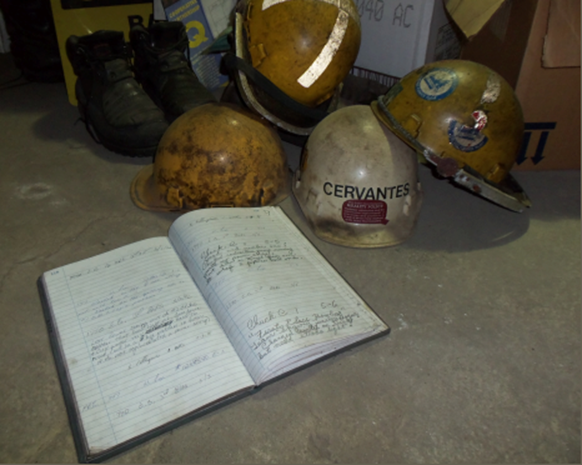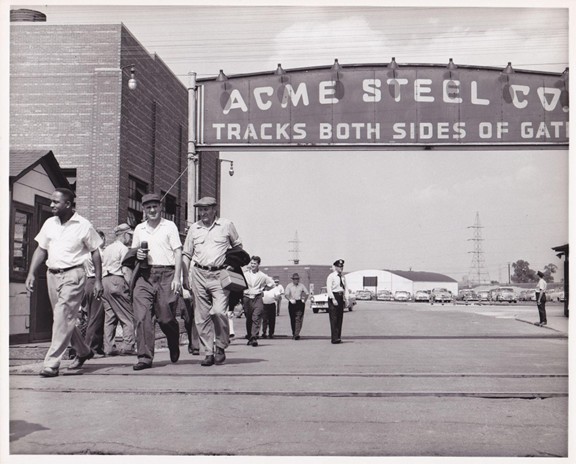Steelworkers walking through ACME Steel gatehouse, circa 1957. Photo courtesy of Tony Arduino.
Joseph Coates is an Assistant Professor of Practice and Assistant Director of the University Library at Purdue University Northwest. His interests are archives and museums, oral history, and information literacy. He is active in the Society of Indiana Archivists, the Midwest Archive Conference, and teaches Public History, Museums, and Archives at Purdue University Northwest. He received his MSLS from Clarion University of Pennsylvania, a BS from Indiana University Northwest, and is currently pursuing an Ed.D. in Leadership and Innovation Design at Purdue University Global.
Emiliano Aguilar is an Assistant Professor of History at the University of Notre Dame. He is a political and labor historian of the United States, with a particular interest in Latino History. A lifelong resident of the Calumet Region (Southeastern Chicagoland and Northwest Indiana), Emiliano has a keen interest in working to acknowledge the region’s national significance. Emiliano received an AB in History and English from Wabash College, an MA in History from Purdue University Northwest, and a Ph.D. in History from Northwestern University.
–
The Calumet Region, spanning Chicago and Northwest Indiana along Lake Michigan, grew exponentially in the early 20th century as a core of the industrial United States. From the shadows of smokestacks to the precipitator dust of steel mills blanketing the landscape, the region’s industries attracted immigrants from across the U.S. and the world. Polish, Italian, African American, and Mexican workers found their place in these factories. Labor unions gained strength by advocating for workers’ rights and fighting for better working conditions1.
As the world changed, so did the Calumet Region. Deindustrialization, driven by automation and the decline of manufacturing, left behind empty buildings and the people whose lives were deeply intertwined with the industries they once served.
At the beginning of the 20th century, companies such as Mark Manufacturing, Youngstown Sheet and Tube, Inland Steel, LaSalle Steel, Bethlehem Steel, and ACME Steel dominated cities like East Chicago, Hammond, Gary, and the South Side of Chicago. Within a few decades, these behemoth facilities made the steel industry of the Calumet Region the largest in the nation.
These mills gave neighborhoods distinct identities, such as South Deering and ACME Steel. Initially incorporated in New York in 1905 as the By-Product Coke Corporation, it merged with Interlake Iron Company in 1964. This merger combined Interlake’s extensive mining, iron, and coke production facilities with ACME’s steel production and finishing capabilities, forming Interlake Steel Corporation, at the time, the nation’s 11th-largest steel producer3.
By the 1970s and 1980s, global competition and the rise of cheaper labor markets led to the outsourcing of steel production. U.S. manufacturing faced intense competition from countries with lower labor costs. In the Calumet Region, mills began to downsize and shutter, beginning with Wisconsin Steel in 1980, and more recently, the indefinite idling of Cleveland-Cliffs in Riverdale. Each new disclosure displaced thousands of steelworkers, who found themselves relocated to other mills, underemployed, or jobless. Behind locked gates, entire histories of facilities sat idle and exposed to the elements and generations of trespassers.
When the ACME coking plant closed in 2001, it left behind not just industrial artifacts but also 100 acres of contaminated land. Built in a swampy area rich in wetlands and once used for fishing, the heavily polluted site became a known threat to both humans and wildlife. ACME is not alone. According to the University of Illinois, more than 1,370 leaking underground storage locations and over 3,800 toxic sites exist across the Southeast Side, south suburbs, and Northwest Indiana, sites that require remediation4.

ACME Steel Artifacts, housed at Purdue University Northwest, Hammond Campus. Photo Courtesy of Joseph Coates.
Though ACME is gone, its legacy lives on through what was left behind. Volunteers salvaged materials from the facility in 2007 and 2008, which became the ACME Steel Collection, housed at Purdue University Northwest in 2022. Through a grant and collaboration with the Calumet Heritage Partnership, the project has completed its first phase, creating a finding aid and offering scholars access to this unique industrial archive5.
The collection is an impressive and thorough history of the ACME facility. Not only does the collection contain personal matters and manuals, but it also contains scale models of blast furnaces, pallets of blueprints from other industries that somehow ended up in this collection. There are over 22,000 aperture cards collected and saved from industrial sites all over the Chicagoland area. From ephemera like helmets and workwear to complaints filed to Human Resources to numerous instruction manuals and procedural documents, the collection is a rich history of the facility and the steel industry.
So far, focus groups and oral history projects are an ongoing project to better understand the role ACME played in the daily lives of residents. The goal is to add the human experience to the collection. These interviews aim to explore not only the economic and environmental impact of the ACME Coke plant but also its social impact on the people who worked there.
These interviews also provided new opportunities to contextualize the collection. Each steelworker who has shared their story has exposed us to their networks and daily work within the mill. From the monotony of some tasks to the potential and real danger of each minute on the factory floor, these workers emphasized the lessons of the mill. Not only do these interviews shed light on the working life, but also on personal life, friendships developed, and how this work affected their homelife. They also spoke of the mental and physical stress of the work and how they coped with it. Even in initial focus groups, steelworkers across generations of the mill collectively shared their bonds of the factory, recalling colleagues who “tapped their shoulders” in the mill to share their knowledge with them as newcomers. They described everything from the repetitive nature of certain tasks to the constant threat of danger on the factory floor, highlighting the lessons learned through their work.
Additionally, some workers have brought new items to add and donate to the collection from their time at ACME Steel. These gifts are not only generous but highlight the value these workers placed on preserving their history on their terms. After one interview, a worker recalled that the run of collective bargaining agreements had to have been stored in his father’s locker, as the basement had flooded and they would have been ruined otherwise. This seemingly minor comment illuminated the care these workers took to preserve their part in the mill, making each steelworker’s home a potential archival site of its own.
Deindustrialization in the Calumet Region reflects broader national trends across the United States. The decline of manufacturing in the latter half of the 20th century was shaped by economic globalization, technological advancements, and evolving labor dynamics. While some parts of the region have experienced modest recovery, the long-term effects of this transformation remain evident. The shift from a steel-based economy to a post-industrial one presents both significant challenges and new possibilities. The purpose of studying this collection is not only to honor and learn from our industrial past, but also to uncover cultural insights within that heritage that may help guide our future. Central to this work are the memories and knowledge of the people who labored on the factory floor and continue to preserve their part in the industrial heritage of the region.
- Moore, Powell A. The Calumet Region: Indiana’s Last Frontier. Indianapolis: Indiana Historical Bureau, 1959.
- Lane, James B. City of the Century : A History of Gary, Indiana. Bloomington: Indiana University Press, 1978.
- Acme Steel Co. (no date) Encyclopedia of Chicago. Available at: http://www.encyclopedia.chicagohistory.org/pages/2524.html.
- Chase, B. (2021) ‘Toxic sites mapped to promote reuse on Southeast Side’, Chicago Sun-Times, 22 February.
- Pete, J. (2025) ‘Acme Steel artifacts from defunct coke plant available for public viewing’, NWI Times, 8 January.
Acknowledgements: The authors would like to thank the archival team at Purdue University Northwest, partners at the Field Museum and Calumet Heritage Partnership, as well as the Albert LePage Center for History in the Public Interest at Villanova University for their support to continue this work.




